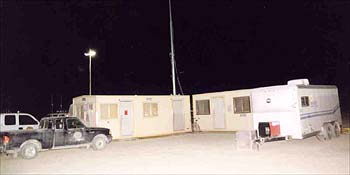The Emergency Services Department of the Black Rock Rangers (ESDR) consists of highly trained professionals from a variety of emergency services fields. These volunteers work long hours to ensure the safety and well-being of all Black Rock City citizens. The ESDR staff also interfaces with outside agencies and other teams within the Burning Man organization, both on-playa and year-round. The core staff consists of four chiefs and a support team of about twenty coordinators, supervisors, and managers. Preplanning efforts require a minimum of 36 internal planning meetings and numerous trips to Nevada to coordinate with outside agencies. The ESDR consists of four branches: Fire, Medical, Communications and Crisis Intervention.

Fire
The Fire branch not only keeps Black Rock City safe from fires that endanger life and property, but more importantly, the Fire branch ensures all intentional “burns” are reasonably safe and enjoyable. The Fire branch cooperates with the Art department, the pyrotechnic team, North Tree Fire (Burning Man’s fire services vendor) and the Ranger Burn Activities Team. The Fire branch’s key role is to provide safety planning and Rapid Intervention Teams during these intentional burns.
The Ranger Fire branch, along with North Tree Fire, provides fire engines and firefighters to the three 24-hour Ranger stations in Black Rock City. Though fire plays a central role in the event, actual fire responses remain consistently low in both frequency and severity.
Medical
The Medical branch works closely with REMSA (Regional Emergency Medical Services Authority), the Fire branch, and North Tree Fire to provide a municipal-style Emergency Medical Services much like that which serves any city in the United States. The Medical branch staffs a 24-hour station at the two community plazas and provides rapid first response medical care anywhere within Black Rock City. Each station has a vehicle dedicated to medical responses, in addition to bike teams on duty. These stations are jointly served by fire engines from North Tree Fire and the Fire branch. These engines also function in an emergency medical service role when needed.
REMSA provides ambulance service within Black Rock City and staffs the Center Camp clinic. REMSA also handles all ground and air transportation to local hospitals.
In 2001, on average there were 200 patient contacts per day, the majority of which were dehydration, “booboos”, and minor injuries. Other common medical problems included lacerations and heat-related injuries. On the whole, serious injuries and deaths associated with the event are statistically lower than average for a city of 26,000 people in a harsh desert environment.
Communications

The Communications branch provides two major services: an emergency dispatch center and the communications infrastructure for the entire event. The dispatch center functions as a 911 public safety answering point. Dispatch coordinates all emergency responses within Black Rock City. The dispatch center also provides the interface to all outside agencies, including law enforcement. Utilizing the latest technologies, the dispatchers have a variety of tools at their disposal, including alphanumeric paging, satellite communications, computer-aided dispatch and radio system control consoles.

 All of the departments that make Burning Man happen depend on reliable two-way radio communications. The Rangers communications infrastructure uses a network of radio repeaters, both on and off the event site, to create a redundant, fail-safe system to function successfully under the harsh conditions of the Black Rock desert. This requires several months of planning and more than 900 staff hours of work.
All of the departments that make Burning Man happen depend on reliable two-way radio communications. The Rangers communications infrastructure uses a network of radio repeaters, both on and off the event site, to create a redundant, fail-safe system to function successfully under the harsh conditions of the Black Rock desert. This requires several months of planning and more than 900 staff hours of work.
The Communications branch also enables departments to communicate throughout the region year-round, coordinating communications between the Gerlach office, Black Rock Station, and Black Rock City.
Crisis
The Crisis Intervention Team consists of six highly trained and dedicated psychiatric professionals. They respond to psychiatric cases, perform crisis intervention for crime victims, and provide victim advocacy to participants who come in contact with local agencies such as law enforcement and local hospitals. This year, as in previous years, they responded to less than a dozen calls on the playa.

